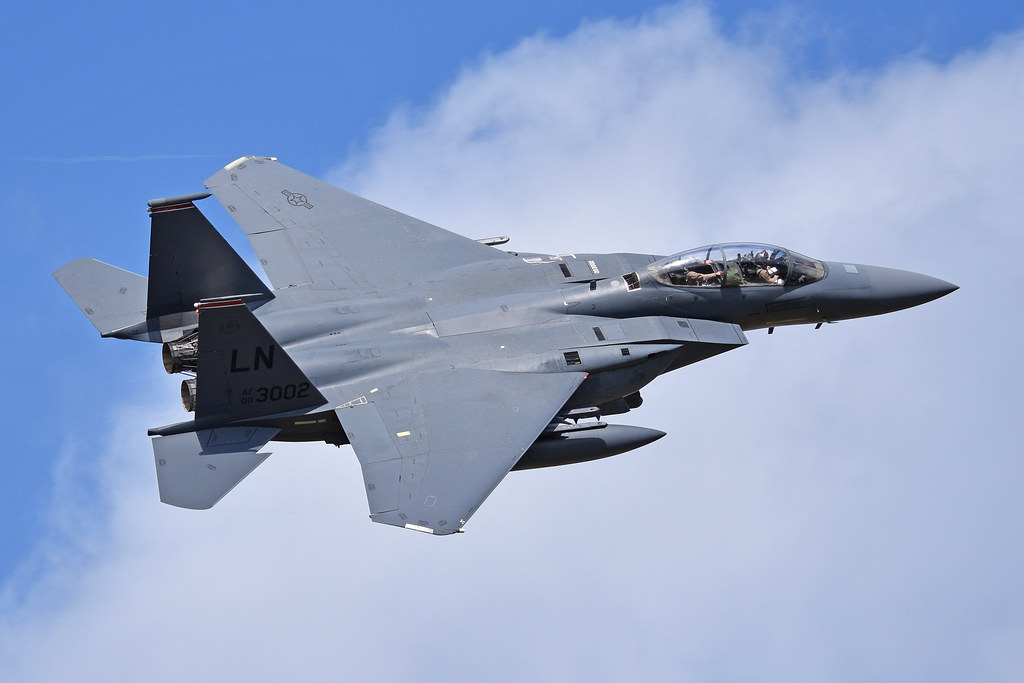
The F-15E Strike Eagle reigns as the fastest aircraft in the U.S. Air Force, surpassing its stealthy cousins, the F-35 and F-22 Raptor, in sheer velocity.

With a top speed between MACH 2.4 and 2.5, approximately 1,875 miles per hour, the Strike Eagle is a true demonstration of aerial prowess.

This remarkable speed can be attributed to its powerful twin Pratt & Whitney F100-PW-220 or 229 engines, enabling the aircraft to skyrocket from idle power to full afterburner in a mere four seconds.

The engines not only deliver a stunning 58,000 pounds of thrust but also provide a vital edge in maneuverability and performance, key qualities for any fighter pilot engaged in air-to-air or ground attacks.

The F-15E has a storied combat record, tracing its lineage back to the F-15 Eagle, which boasted an undefeated record of 104 aerial victories with zero losses.

Its inception was inspired by the need for an aircraft that could dominate in both air combat and precision ground strikes, a role it has fulfilled with distinction in conflicts from Operation Desert Storm to the ongoing operations in the Middle East.

This multi-role fighter’s capabilities are not just limited to air combat. It can carry a substantial load of 24,500 pounds of munitions, making it an intimidating force in any theater of war.

Notably, during the Gulf War, an F-15E Strike Eagle achieved an air-to-air kill against an Iraqi Mi-24 attack helicopter using a laser-guided bomb—a testament to its versatility and the skills of its operators.

The F-15E’s cockpit is designed to maximize efficiency and lethality. The pilot focuses on flight maneuvers while the Weapons Systems Officer or “Wizzo,” stationed in the back seat, manages the complex array of weapons and sensors, collaborating with both ground and airborne command to execute precision strikes.

As the U.S. Air Force looks to the future, the F-15EX emerges as the heir to the Strike Eagle’s throne.

This new variant is set to enhance the legendary capabilities of its predecessor with state-of-the-art sensors, radars, and an advanced battle management system.

Not to be outdone by its speed, the F-15EX will also be capable of deploying hypersonic weapons, ensuring its place in the vanguard of modern warfare.

The F-15’s enduring service is a story of innovation and adaptation. Despite the emergence of more advanced fighters, the Eagle and its variants continue to be a critical component of U.S. air superiority, with the latest models poised to extend the platform’s service well into the 21st century.

The legacy of the F-15 family represents a remarkable half-century of operation—a testament to its design, capabilities, and the strategic foresight of the U.S. Air Force.

As military tech and politics enthusiasts marvel at the intersection of science, nature, and defense innovation, the F-15E Strike Eagle stands as a thrilling example of how the principles of speed, agility, and firepower coalesce to form an aircraft that not only shapes military history but also promises to be part of its future.
Relevant articles:
– Why the F-15E Strike Eagle Is the U.S. Air Force’s Speed King, The National Interest
– Here’s Why America’s F-15 Eagle Keeps Fighting, And Why It Isn’t Going Anywhere Soon, The National Interest
– Why the F-15 Is Such a Badass Plane, Popular Mechanics
– Airframe: The F-15 Eagle, Airman Magazine (.mil)

